Art Fairs
6 of the Best Artworks at Frieze Los Angeles 2023, From a Jennifer Bartlett Masterwork to a Powerful Debut by a 24-Year-Old Rising Star
Read on for Artnet News's editor-in-chief's picks from the fair.
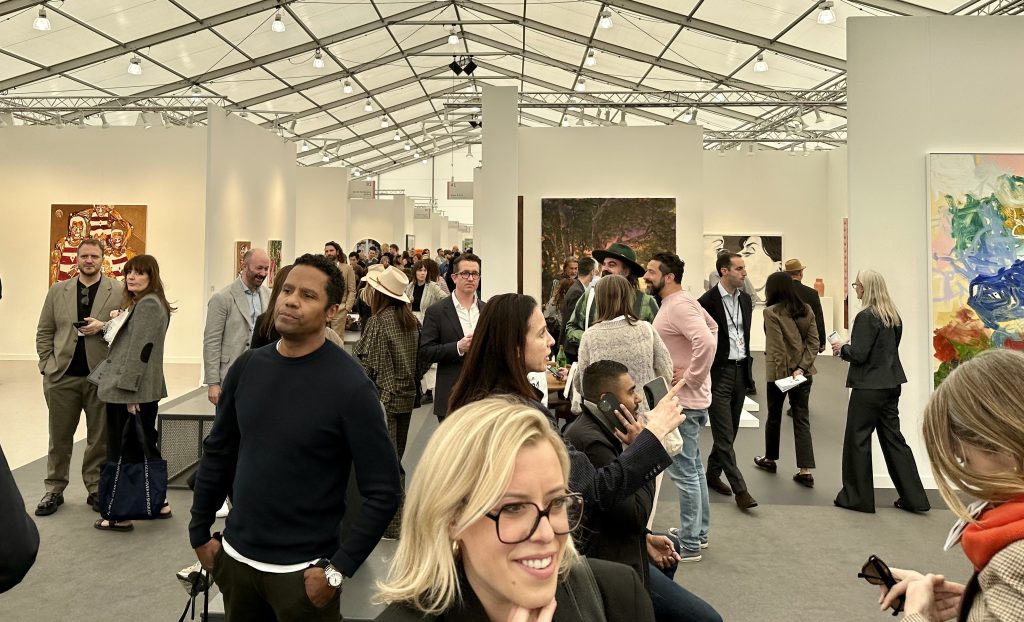
Read on for Artnet News's editor-in-chief's picks from the fair.

Andrew Goldstein

Ah, Frieze Los Angeles—it’s a pretty great art fair. There’s plenty to see, excitement in the (unseasonably chilly) air, the occasional frisson of a celebrity sighting, and excellent discoveries to be made from artists both young and old. Here are a few of the standout artworks in the fair this year.
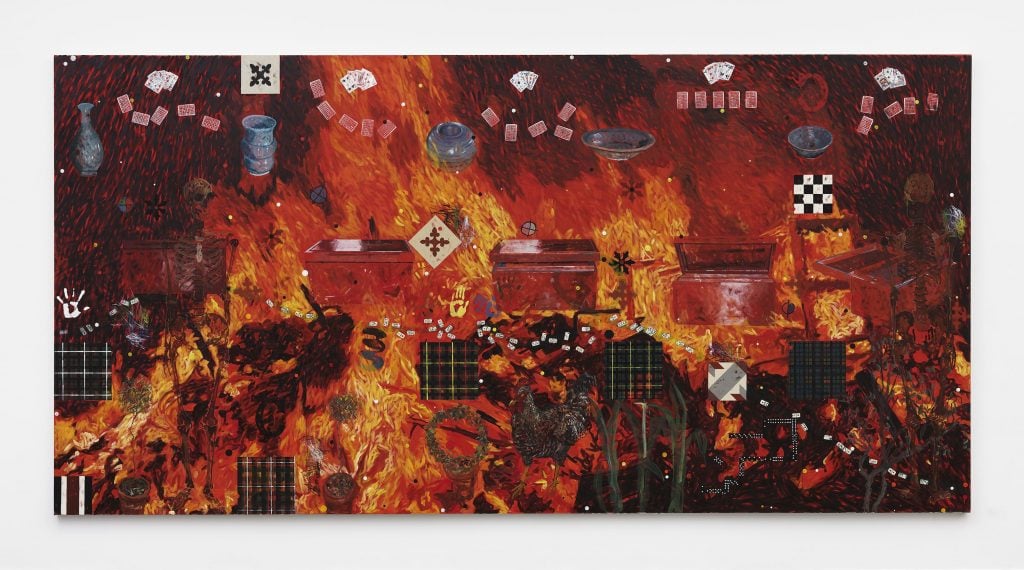
Photo: Object Studies. Copyright: © Jennifer Bartlett Courtesy Marianne Boesky Gallery, New York and Aspen; Paula Cooper Gallery, New York; and the Jennifer Bartlett 2013 Trust.
Those familiar with the artistically and intellectually potent work of Jennifer Bartlett, the painter who died last year at age 81, may be surprised by her work at the fair. Whereas she is best known for her rigorously structured, mathematics-derived canvases—the kind of work that led Roberta Smith, her great critical champion, to call her a “conceptual painter on vast scale”—the central painting on view at Boesky’s booth is explosive, frightening, almost cinematic. Stemming from a shift in which Bartlett transitioned away from her acclaimed aluminum-plate sequences of the 1970s toward a freer, looser hand, the artwork depicts a human skeleton standing in an abstracted domestic setting engulfed in flames, surrounded by sequences of playing cards, dominoes, wooden chests, game boards, and squares of tartan plaid.
Never before displayed in California, where Bartlett was born, this painting has doomy local resonance in a time when one year of massive wildfires has been replaced by one of cataclysmic rains. It wasn’t so different during the artist’s youth. As her friend Joan Didion wrote, “Children [in California] grow up aware that any extraordinary morning their house could slip its foundation in an earthquake…. Jennifer Bartlett’s most persistent imagery, her apprehension of the potential for disaster in the everyday, derives from her California childhood.” Of course, the artist’s interest in systems and pattern-making is present amid the chaos: the games and plaid strewn around the painting are instances of math made quotidian, things you can find around your home.
Today, Bartlett occupies a funny place in the art conversation. She’s not a household name, but she’s not exactly under-recognized. Her market has been evolving steadily. The January opening of her posthumous show of drawings at Boesky’s New York gallery was jam-packed with her artist and critic fans. But has she gotten her due? One almost hopes that someone from the tech community will see her paintings at the fair, recognize a kindred spirit in the pursuit of that quasi-mystical intersection of data and everyday life, buy some work, tell their friends, and make her into a real phenomenon.
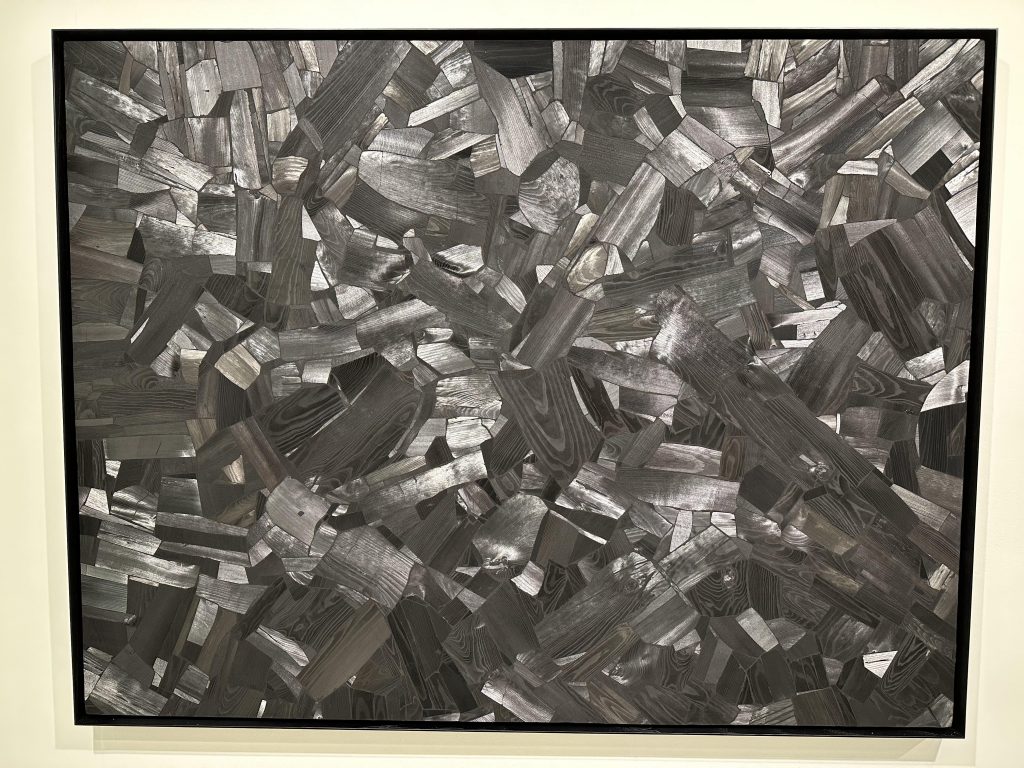
Lee Bae, Issu du feu (1998). Photo by Andrew Goldstein.
With unaccountably luscious surfaces that darkly shimmer in the light, the artist Lee Bae’s charcoal paintings draw you in for closer inspection to discern how they do what they do—it’s no wonder that the dealers at Johyun Gallery have come to call them “people magnets.” The mystery somehow only deepens when you learn that these paintings are not made with charcoal, laying it down on paper or canvas, but rather from charcoal, with the artist slicing thick slabs of burnt pine and then inlaying it like black mother of pearl to create the surface.
Bae began working with charcoal as a signature material three decades ago when, living in Paris, he found lumps of it for sale in a store and realized that it not only reminded him of his native South Korea, where it is a staple of daily life, but that it was a cheap and plentiful material he could count on. Furthermore, its status as a tree that had become fire and then a carbonized relic ready to become fire again appealed to him as having a certain circle-of-life poetry to it.
Now 67, Bae is a superstar in South Korea with long waiting lists for his work, but his gallery is intent on expanding his market into new territories. Last year, they brought his paintings to the Armory Show in New York, where one was bought by a “famous collector” right away. Here in Los Angeles, another one—and they range from $100,000 to $250,000—sold to a prominent U.S. collector in the opening hours of the fair.
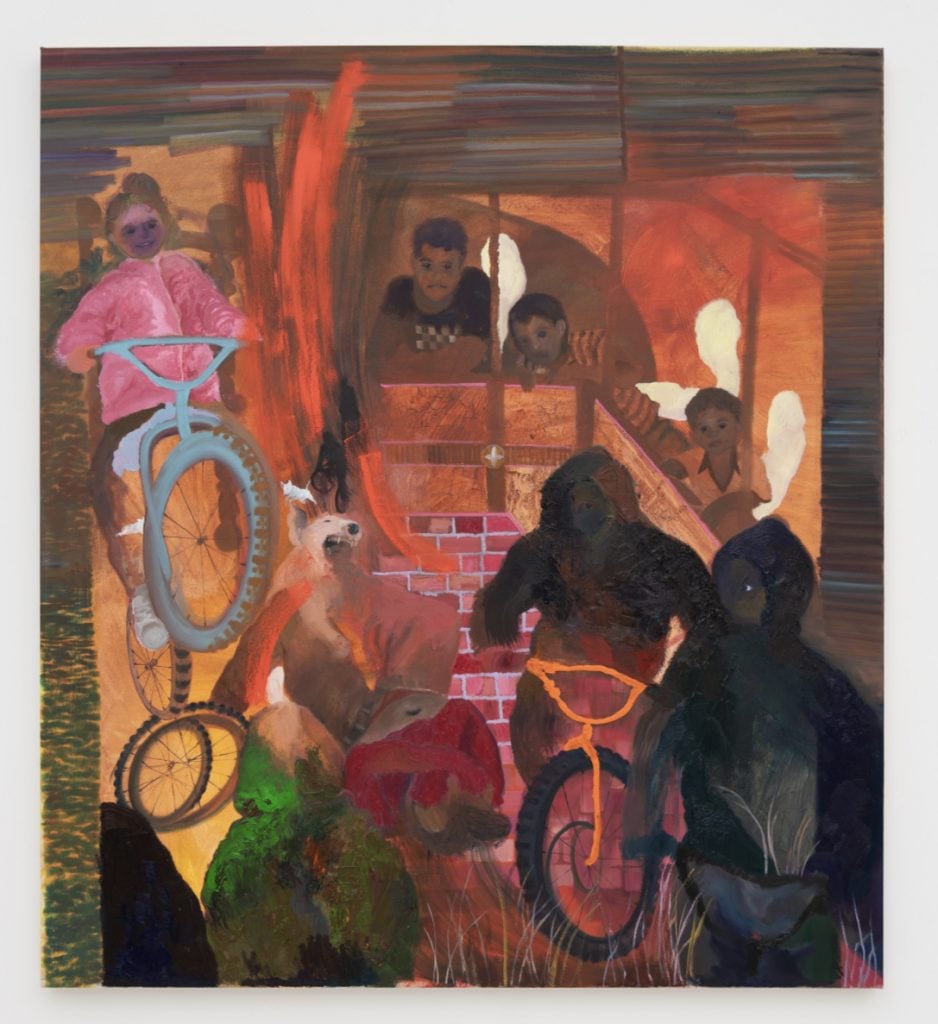
Veronica Fernandez, I Don’t Want to Die (2023). Courtesy of Sow & Tailor Gallery, Los Angeles.
As an artist, Veronica Fernandez is something of a miracle: she is only 24 years old (she was born in 1998), has only been painting for about three years, and is clearly a supercharged talent, using the brush both gesturally and with precision to create riveting, dreamlike scenes. And, in an art world filled with nepo babies (and grandbabies), Fernandez experienced an impoverished upbringing, spending much of her youth changing homes and facing eviction in New Jersey with her family—and still, through her talent, was able to earn a BFA from the School of Visual Arts last year and now has come to a place where her work is for sale at the Frieze art fair.
The paintings on view here meld her talent and story. Based on poems she wrote about her family’s ordeal and photographs from her and her sister’s childhood, the scenes show her conjuring an imaginative space of comfort and home amid instability: making a play fort in one painting, riding a barren mattress like a gondola through a sea of colorful disco balls in another, or here, in this one, cheerfully riding her bike amid barking dogs and unsavory characters as her family members watch with concern. (Its title, I Don’t Want to Die, is chilling.)
Fernandez paints quickly and with urgency, laying down her memories and imaginings in a way that creates a definite mood. In her largest canvas at the fair, figures of adults and children trudge through a wasteland, tied together by ropes looped around their waists. They are on a long trek, the ones in the front carrying forward the ones behind. Maybe Fernandez’s art can lighten the load.
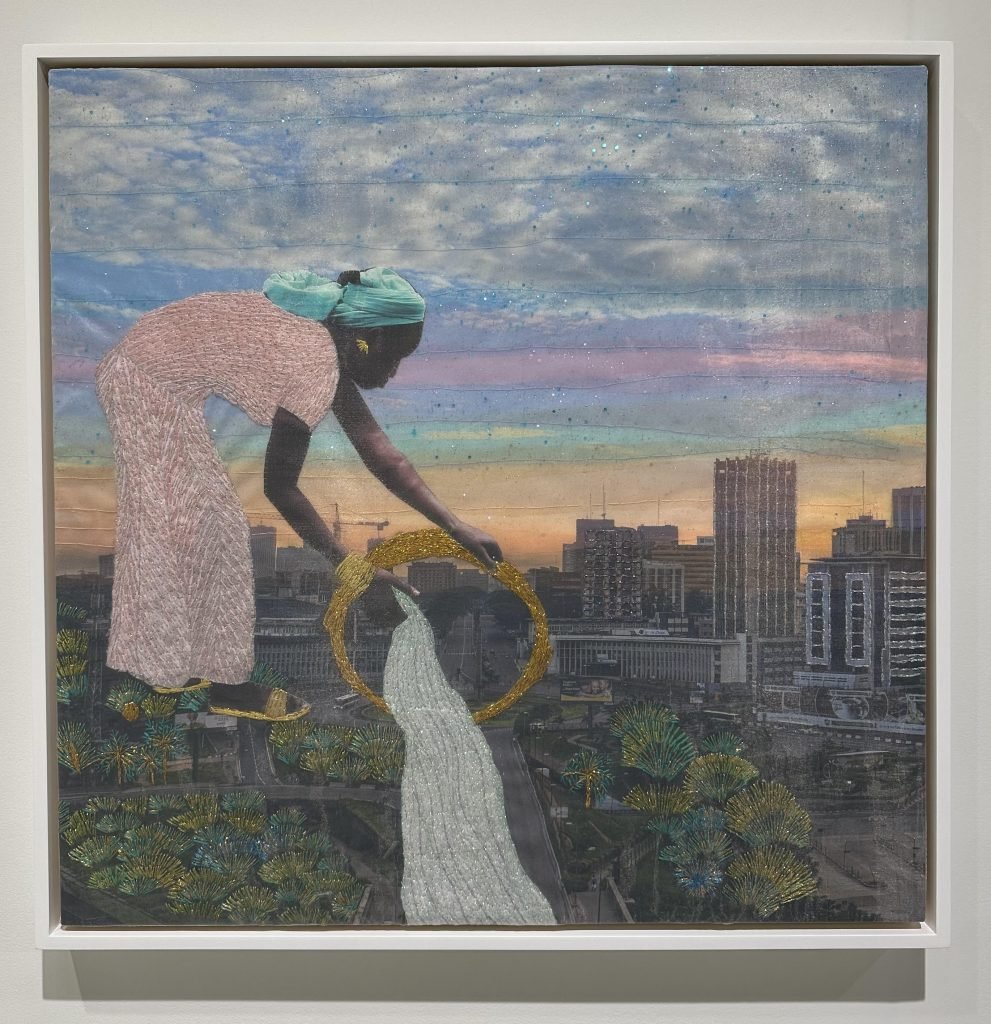
Joana Choumali, Silence, Too, Is an Answer (2022). Photo by Andrew Goldstein.
Based in Abidjan, Côte d’Ivoire, Joana Choumali used to go to the beach resort of Grand-Bassam with her family as a child. After a 2016 attack at the resort left 19 people dead, unsettling the shaky peace following the country’s civil wars, she returned there to make art in an attempt to make sense of the atrocity, memorialize the victims, and heal wounds. The resulting series consists of photographs that she took of lonely figures in desolated settings and then printed on canvas, allowing her to embroider the figures and their surroundings with lustrous threads, imbuing the scenes with a colorful feeling of hope. Called “Ça va aller,” or “It’s Going to Be Okay,” the body of work won her France’s prestigious Prix Pictet in 2019.
This caught the attention of Angela Westwater, the fabled dealer and cofounder of Sperone Westwater Gallery, which is best known for its work with Bruce Nauman and postwar Italian artists like Carla Accardi, but which in recent years has been bringing on a younger generation of talents. On a trip to London, Westwater saw a magnificent triptych by Choumali in a 2021 group show at the Royal Academy. That piece, plus the fact that the Victoria & Albert Museum had acquired a work, led to a series of Zoom calls with the artist and now gallery representation—despite the fact that Westwater and Choumali have not yet met in person, a lingering product of the pandemic.
At the fair, the artwork on display by Choumali—from her “Alba’hian” series—has wow factor to spare. Stemming from photographs the artist takes on early-morning walks in Abidjan and then prints onto canvas, this surface is then enlivened by a solitary portrait she cuts out of a separate shoot and then stitches on top, painstakingly overlaying the lines of her imagery with thread before finally covering the whole composition with a diaphanous piece of tulle. The gauzy effect comes across well in a photo, but in person it’s hypnotizing. Next up? Another Zoom call between Westwater and Choumali, and then, if all goes well, a show at the New York gallery by the end of the year.
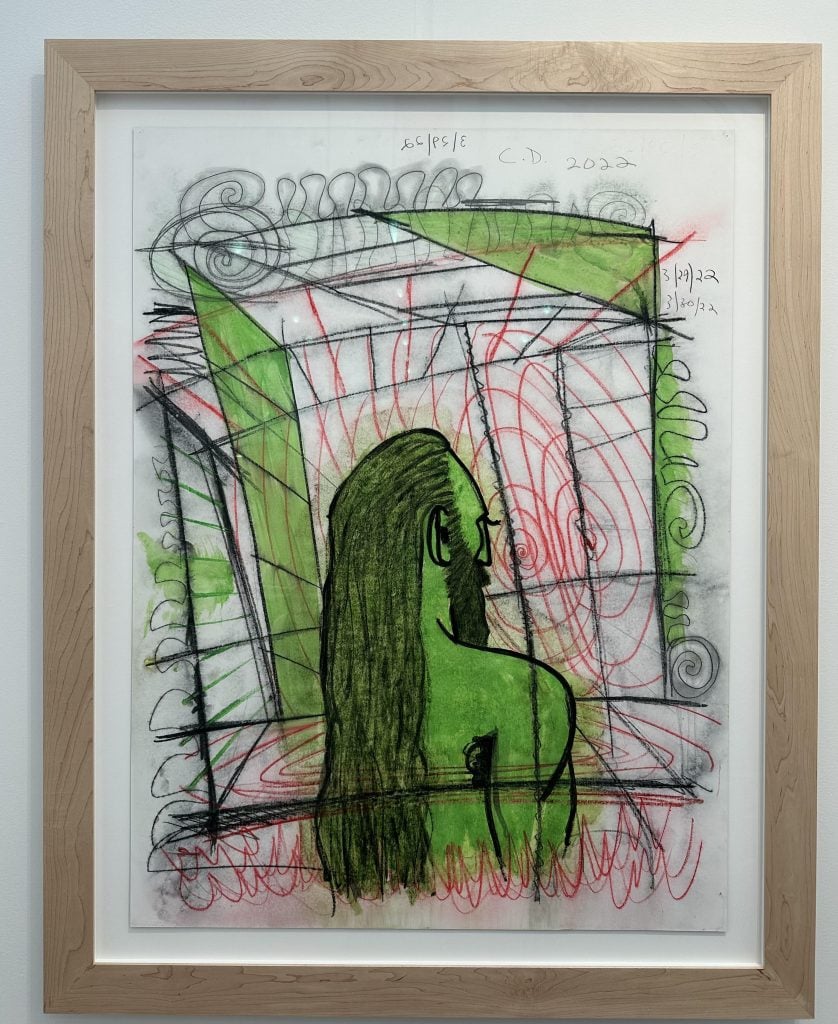
Carroll Dunham, Untitled, 3/29/22, 3/30/22 (2022). Photo by Andrew Goldstein.
That the painter and printmaker Carroll Dunham is one of the greatest artists of his generation still seems to be something of a secret, which is funny because he has all the hallmarks: an instantly recognizable hand, distinctive subject matter that provides timeless pools of mysterious reflection, and a career’s worth of work that shows continual evolution. In recent years, he has been working with an enigmatic male figure dubbed “the Wrestler” (the successor to the female “Bather” of his earlier work), who has a habit of engaging in primeval combat with doppelgängers of himself but also getting lost in what appears to be deep, philosophical thought.
In Los Angeles, Gladstone Gallery has transformed its office space into a showroom for a series of monoprints in the latter, contemplative vein, while the the base canvas for the series is on display at the fair. It shows the Wrestler from a rear three-quarter view, colored green like some ancient chthonic entity, long hair and beard falling from a body that is limned with thick, decisive lines. His brow is furrowed and his gaze trained on the center of a red vortex in the background. Around him is a Bacon-esque cage—are those red lines below him are flames?—the lines and squiggles give the setting a pulsating feel, like he’s traveling between dimensions.
Who is this green Wrestler, and what is he up to? A clue, apparently, is that Dunham has a longstanding interest in science fiction. What’s certain is that he furnishes a perfect opportunity for the artist’s formal explorations, and the series of prints that arose from this base canvas—produced at Two Palms press in SoHo—are wonderfully weird, with blottings of diluted ink creating a hallucinatory effect. Right now, Dunham’s prints are also the subject of a major survey at the National Gallery in Oslo (where the Queen is an avid printmaker herself), and this May, Gladstone will unveil a new series of drawings in New York that will introduce a never-before-seen formal element to his work. What adventures will our friend the Wrestler embark on next? Stay tuned.
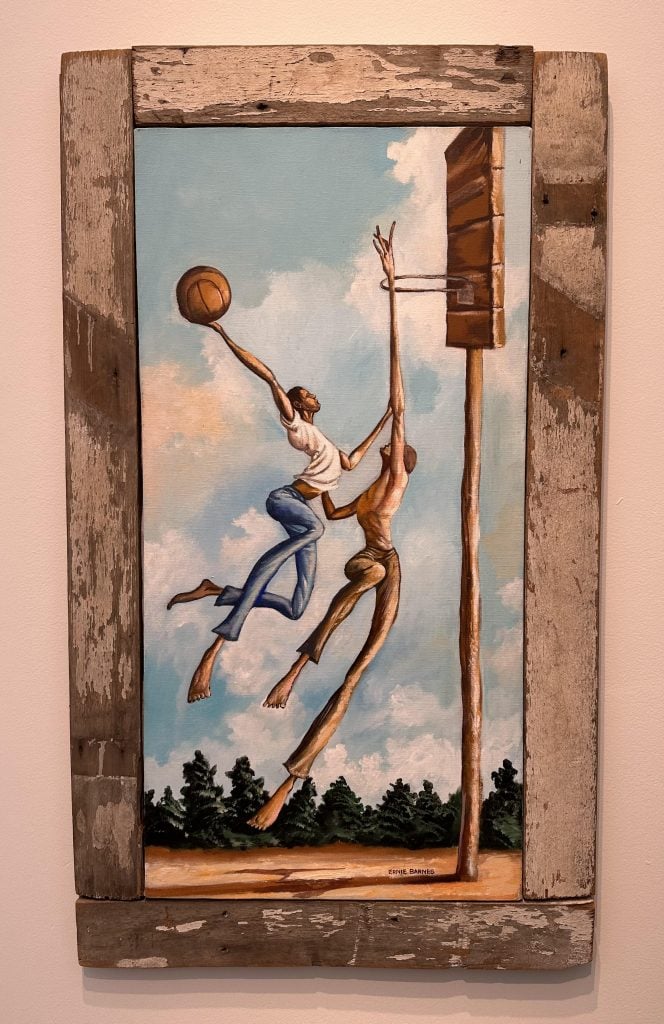
Ernie Barnes, Protect the Rim (1976). Photo by Andrew Goldstein.
It was in the early, scary, lonely days of the pandemic when the art dealer Andrew Kreps was googling some artists he was interested in and fell down a rabbit hole of overlooked American painters that led him, search query by search query, to Ernie Barnes. A fascinating figure whose life story strikes as movie-ready today but which didn’t quite make sense to the art establishment of his time, Barnes had wanted to be an artist ever since he was a kid, but as a Black child in segregated Durham, North Carolina, that path was not really open to him—whereas football was a path that, as a gifted athlete, he could run down at full speed. So he got a full athletic scholarship to attend the all-Black North Carolina College, where he majored in art while dazzling scouts on the football field, leading him to a pro career first with the Baltimore Colts, then the New York Titans, then the San Diego Chargers, then the Denver Broncos. Throughout his football career, Barnes made art, sketching even during team meetings—something his Denver coach would fine him $100 for when caught—and earning the nickname “Big Rembrandt” among his teammates. (He and the Dutch master share a birthday.)
After playing for five years, Barnes became eligible for a pension and quit to do art full time, painting in a style inspired by Thomas Hart Benton, Andrew Wyeth, and other midcentury American regionalists that he dubbed “Neo-Mannerism.” That expressive, elongated style is on full display in this painting of two basketball players leaping into a sky reminiscent of a brighter El Greco, framed by raw wooden planks that somehow manage to simultaneously evoke a southern shack and a Renaissance icon. He quickly found success—his first post-retirement show in New York sold out, he became the “official artist” of the 1984 Olympic Games in Los Angeles, he won celebrity collectors in the Black entertainment world like Richard Roundtree and Berry Gordy, and his art was featured in seminal pop-culture contexts from a Marvin Gaye album cover to (most famously) the set of the TV show Good Times. But, during his lifetime—he died in 2009—the fine art world kept its distance.
Suffice to say, all that has changed. In 2020, the UTA Artists Space in L.A. gave Barnes a solo show, Kreps mounted a show in 2021, and momentum began to grow behind his market until, bang, his 1976 painting The Sugar Shack woke everyone up when it sold for $15.3 million at Christie’s in May 2022. Since then it’s been off to the races, and Kreps and Ortuzar Projects’s booth at Frieze was the equivalent of a touchdown dance in the end zone, with the artist’s family hanging around in “Team Barnes” sweatshirts and stars like Lionel Richie and Tyler the Creator coming by to pay respects among artworks ranging from $2.2 million (for a painting titled Street Song) to works on paper in the $60,000-to-$125,000 range. And just think: UTA, the eminent talent agency that brought Barnes into the present-day spotlight—and which is currently displaying Sugar Shack at its West Hollywood art space—is mainly interested in his life rights for film and TV projects. Expect Barnes’s fame to only grow from here.
Frieze Los Angeles is on view at the Santa Monica Airport, 3026 Airport Ave, Santa Monica, California, February 16–19, 2022.